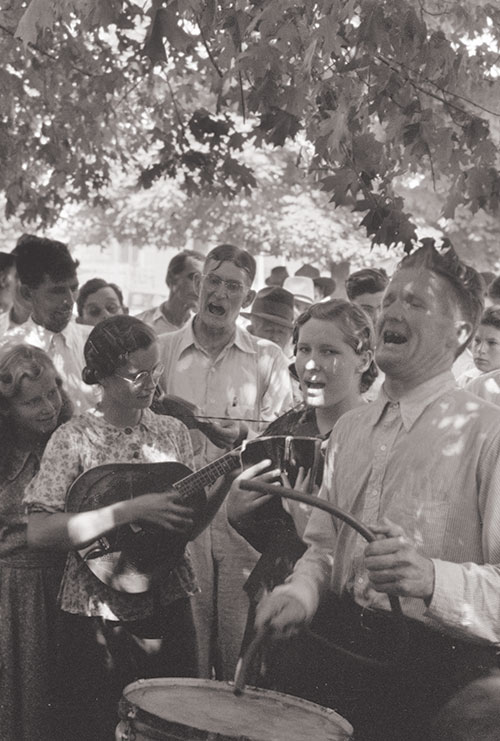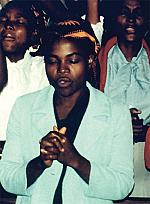Seven characteristics of revivals

[Above: Russel Lee, Revivalist rally under tree in square, Saturday afternoon, Tahlequah, Oklahoma, 1939. Nitrite Negative—Public domain, Library of Congress]
Revivals in the Christian tradition commonly show seven characteristics. In most revivals we see the first characteristic and a number of the others, but seldom all seven.
1. Intensified experience is a defining quality. Participants in revivals show a vivid sense of spiritual things, great joy and faith, deep sorrow over sin, a passionate desire to evangelize others, and heightened feelings of love for God and fellow human beings. A revival is typically understood as a communal event, in which groups of people share this sort of heightened experience.
2. Bodily manifestations—such as weeping, shouting, fainting, dancing, and so on—are also common. Though some assume that these sorts of manifestations occur only in Pentecostal revivals, the documented history identifies this feature in the revivals of a wide range of religious groups, including Calvinists, Quakers, Baptists, Methodists, and adherents of the Holiness movement, as well as participants in the twentieth-century Pentecostal and Charismatic movements. The second characteristic is linked to the first. The intensification of experience is not confined to the spirit, heart, or mind, but commonly reveals itself in the physical body. Participants in revivals often report sensations of warmth or electricity in their bodies, while others fall to the ground in an unconscious or semiconscious state. Some experience an urge to dance, shout, or testify to others. Some speak in tongues, see visions, or receive divine healing.
3. Extraordinary occurrences often accompany revivals, interpreted by the participants as “signs and wonders” of God’s presence. These may involve unlikely coincidences— someone prays for financial help and suddenly money turns up from an unexpected source. They may involve supernatural knowledge in the form of dreams, visions, or revelations regarding the secrets of an individual’s life or concerning future events. They may involve spiritual or divine healing. Whether or not these events are proper miracles as such—however one defines that term—they strike the participants as signs that God is working among them.
4. Issues of spiritual discernment. Religious revivals almost always force participants to distinguish between nature and grace, between human initiative and divine influence. They may also stimulate discussion regarding God and Satan, or angelic versus diabolical manifestations. Critics of revivals often utter charges of manipulation by leaders, mass hysteria, or emotionalism. Defenders, though they see the revival overall as a divine work, usually acknowledge that at least some participants in the movement are carried away by their own emotions and thus are not being “led by God.”
5. Issues of lay and clerical authority: Who is in charge? People in the midst of an intense spiritual experience often feel that their words and actions carry special authority and may be directly sanctioned by God. Consequently lay participants may believe that they are not bound to follow the directives of their clerical leaders. Thus a familiar clash arises between “charismatic” and “official” leadership in the midst of and in the aftermath of a revival. (This fifth characteristic is often tied to the fourth, as people seek to discern which leaders are speaking on God’s behalf.)
6. Conflict and division in church and community. Religious revivals are almost always controversial, causing deep disagreements between the participants and the nonparticipants, and/or among participants themselves. These conflicts usually center on the characteristics already mentioned—intensified experience, bodily manifestations, extraordinary occurrences, and issues of discernment and authority. Since different people assess the revival phenomena in different ways, disagreements are bound to arise. Often the participants in a revival stigmatize the nonparticipants as unspiritual, while nonparticipants regard the participants as fanatical. While these disagreements may occur during the period of a religious revival, they typically take place later. Much of the controversy concerning the Great Awakening, for example, did not take place in the heat of the revival in 1740–1741, but rather in 1743–1745.
Sometimes disagreements over revivals lead to permanent organizational and institutional divisions (e.g., “New Light” vs. “Old Light” Congregationalism, the Methodist churches vs. the Holiness churches, the Holiness churches vs. Pentecostalism).
7. The emergence of new associations, organizations, and institutions. Revivals not only bring conflicts and divisions, they also engender new forms of association and connection between individuals and groups. The Great Awakening helped to spawn a new kind of transdenominational evangelicalism in North America, while the Second Great Awakening encouraged the formation of numerous voluntary associations devoted to various social causes (abolitionism, temperance, women’s rights, etc.). The social and institutional legacy of a given revival may be extremely complex, involving both the severing of old ties and the forging of new alliances.
REVIVAL: IDENTITY AND EFFECTS
These seven characteristics indicate that religious revivals, for all their influence on the individuals who undergo them, have definite social, historical, and cultural effects. The shared ecstasy that often occurs in the midst of revivals can have lasting impact on the participants. The sociologist Émile Durkheim (1858–1917) referred to this as “collective effervescence,” noting that powerful, shared experiences can engender a new sense of social identity. It may lead people to view themselves and one another in new ways. It may lead laypeople to challenge those in positions of authority. It may lead people of differing social classes, races, or genders to discover a new affinity with one another.
One enduring—and notoriously complex—issue pertains to the social effects of religious revivals. Was the 1740s Great Awakening—in stressing the religious identity, value, and dignity of ordinary people—a kind of inadvertent preparation for the American Revolution in 1776? Was the Second Great Awakening of the early 1800s a key factor in promoting opposition to slavery in the United States prior to the Civil War? Some scholars say yes in both cases. Though the matter is hardly settled, there is at least some evidence linking religious revivals with movements of social change and reform, and this underscores the fact that revivals are corporate, collective events that may affect large groups of people at significant times in history. CH
By Michael J. McClymond
[Christian History originally published this article in Christian History Issue #153 in 2024]
Michael J. McClymond is professor of modern Christianity at St. Louis University and scholar of the history of Universalism, global evangelicalism, and the Pentecostal-Charismatic movement.Next articles
Fiat or partnership?
Theologies of revival may be closer in practice than they are in theory.
Michael J. McClymondSupport us
Christian History Institute (CHI) is a non-profit Pennsylvania corporation founded in 1982. Your donations support the continuation of this ministry
Donate







